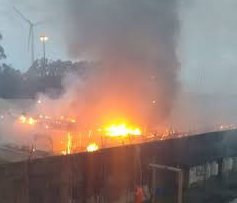Heathrow Airport’s sudden shutdown leads to chaotic diversions, with pilots unsure of landing options.
Heathrow Airport’s closure on 21 March 2025, following a catastrophic fire at an electrical substation, has caused widespread disruption, with flights diverted and thousands of passengers left in limbo. Among those affected was a passenger flying from Bangkok to London, who revealed that the pilot informed the cabin mid-flight that they were uncertain of where to land due to the airport’s sudden closure.
As the airport shut its doors early in the morning after a fire disrupted power supplies, 120 planes en route to Heathrow were forced to seek alternative landing sites. Tim, a passenger on one such flight, described the chaotic scene when the pilot told them: “We don’t know where we’re going to go yet. Stansted’s full, Gatwick’s full, we’re trying to find somewhere we can land.”
Ultimately, the plane was diverted to Brussels, with Tim acknowledging that landing in Belgium was preferable to being sent back to Asia. However, passengers were left stranded on the tarmac for four hours without food or drink, frustrating many.
“We refuelled, and now we’re just waiting for a slot to get back to the UK,” Tim explained, still uncertain about when they would be able to return.
The fire at the North Hyde electrical substation, which caused the widespread power outage, resulted in the deployment of at least 70 firefighters to manage the situation. The closure of Heathrow affected around 1,351 flights, with up to 300,000 passengers expected to travel through the airport on that day alone.
Heathrow urged passengers not to travel to the airport and advised them to stay in contact with their airlines for further updates. With the shutdown expected to continue throughout the day, passengers have been left grappling with significant delays and cancellations.
The incident highlights the vulnerability of critical infrastructure and the need for robust contingency measures in case of emergencies like this. As recovery efforts continue, the full impact of the disruption on global travel remains to be seen.

